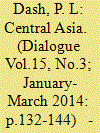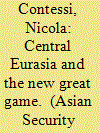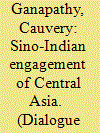|
|
|
Sort Order |
|
|
|
Items / Page
|
|
|
|
|
|
|
| Srl | Item |
| 1 |
ID:
129416


|
|
|
|
|
| Publication |
2014.
|
| Summary/Abstract |
In 2011-2012 all Central Asian countries have celebrated 20th year of their independence. They have achieved commendable progress in all spheres of their life during these years. Getting over from the monolithic ideology of communism, they have shifted to something that is not similar to any system. However, three areas are clearly discernible in the transition process of the last two decades: economy, society and ideology. The economy is no longer the command socialist economy. It is opening up, in some areas rapidly and in others slowly. Predominant private economic activities are visible in the market places. In laying the foundation of modern industry they are less visible. Foreign Direct Investment has been steadily flowing with varying degree of success in each country depending how investment savvy the FDI rules have been. The State has retained control over all spheres of economic activities. The society is no longer the communist one with free education and kindergarten, full employment guarantee to all, free housing, free medical care and many other benefits. All these have vanished. Everyone has to
fend for himself and his family. This is where it has created a schism between the haves and the have-nots thereby polarizing the society into rich and the poor. In the ideological realm, the Marxist-Leninist ideology has been completely given up. Even in academic libraries it is hard to find the works of Marx and Lenin that once adorned the shelves. Instead, works of incumbent presidents occupy the stacks. There is an irony: what the people wish to preserve, the presidents do not desire to protect.
|
|
|
|
|
|
|
|
|
|
|
|
|
|
|
|
| 2 |
ID:
124876


|
|
|
|
|
| Publication |
2013.
|
| Summary/Abstract |
In the 20 years since independence from the former Soviet Union, the study of Eurasia in International Relations (IR) has received considerable impetus in both the academic and policy circles. Specialized news and analysis outlets have come online, research centers have multiplied within universities, and a variety of think tanks now host dedicated programs. In other words, this still relatively little-known region has glamour. Yet Eurasia remains difficult to situate as an object of study due to its distinctive hybridity: geographical, at the crossroads between Europe and Asia; cultural, Muslim Russianspeaking Turkic peoples with Asian traits and traditions; political, straddling Western and Asian institutional forms domestically, and contiguous to Europe, Asia, Russia, the Middle East, and Afghanistan internationally. Partly as a result of this hybridity, Eurasia is a somewhat elusive object of study. At a minimum, it comprises the two subregions on each shore of the Caspian basin: Central Asia to the east and the Caucasus to the west. Reflecting this elusiveness, Central Asian states (CAS) belong to the Asia-Pacific Regional Group at the United Nations; they are members of the Asian Development Bank and the Economic Commission for the Asia-Paci?c. At the same time, they are members of the Organization for Security and Cooperation in Europe (OSCE), the European Bank for Reconstruction and Development, and the Euro-Atlantic Partnership Council, a North Atlantic Treaty Organization (NATO) ancillary forum. But they also have distinctly Central Asian groupings, such as the Eurasian Development Bank, the UN-af?liated Central Asian Regional Information and Coordination Center, not to mention the Shanghai Cooperation Organization (SCO) and Collective Security Treaty Organization (CSTO). Similarly, the three Caucasian states share most of the same af?liations, except for belonging to the East European Regional Group at the UN
|
|
|
|
|
|
|
|
|
|
|
|
|
|
|
|
| 3 |
ID:
129412


|
|
|
|
|
| Publication |
2014.
|
| Summary/Abstract |
Tensions around water distribution and consumption has assumed such proportions that experts have started talking about hydro-conflict and hydro-war in Central Asia . No other region in the world has faced such security peril linked to water. Crux of the matter is that water resources of the countries of
Central Asia are not distributed equitably. The region is clearly divided into water-rich States like Tajikistan and Kyrgyzstan on the one hand, and countries like Uzbekistan, Turkmenistan and Kazakhstan dependent on them for water, on the other. While Kirgyzstan controls the riverbasin of Syrdaria, Tajikistan controls water resources of Amudaria. Syrdaria is the longest and second largest in terms of water resources in Central Asia. Syrdaria with a length of 3019 km covers an area of 219 thousand square km. The major part, 75.2 percent of water resources of Syrdaria is formed in Kyrgyzstan, 15.25 percent on the territory of Uzbekistan, 6.9 percent in Kazakhstan and 2.7 percent in Tajikistan . Amudaria river has a length of 2540 km, with a basin of 309 square km. Like Syrdaria, Amudaria loses much of its water resources for irrigation purpose in the downstream. The major portion of water resources of Amudaria (74 percent) is formed on the territory of Tajikistan, while 13.9 percent of the water is formed in Afghanistan and Iran, and only 8.5 percent on the territory of Uzbekistan
|
|
|
|
|
|
|
|
|
|
|
|
|
|
|
|
| 4 |
ID:
129427


|
|
|
|
|
| Publication |
2014.
|
| Summary/Abstract |
In the Sino-Indian dynamic, there are several theatres of play - thematic and geographic. One such crucible in this competition is the Central Asian space. There is much Indian diplomacy could learn from the Chinese pursuit of Central Asia. There is, however, also many allowances that those scrutinising India's position in Central Asia need to make before announcing their final verdict on the subject. The compulsions of a formalised structure of education, often trumps the catholicity in the pursuit of knowledge. So attuned does the understanding of an area become to the straightjacketed contours of
the academic training imbibed, that it threatens a rightful appreciation of the myriad variables which define a subject. The study of India's relations with Central Asia has variously been the interest of academics who study it through the prism of a singular domain of expertise - economic, political, social, anthropological, and historical, among others. Such focused attention undoubtedly ensures a level of expertise that a multidisciplinary approach cannot guarantee; and yet, it is perhaps equally true that it is well-nigh impossible to gauge the value of India's engagement with the Central Asian States on the basis of a single discipline. An almost natural tendency to do this portrays India's Central Asian story as abysmal when compared with China's. Such a narrative overlooks the possibility that China and India's stakes in the Central Asian region are far from being equal, much less the same.
|
|
|
|
|
|
|
|
|
|
|
|
|
|
|
|
| 5 |
ID:
129413


|
|
|
|
|
| Publication |
2014.
|
| Summary/Abstract |
The problem of water supply and share of trans-boundary water resources today are particularly acute in Central Asia. Disruption of earlier economic relations between the former Soviet republics of Central
Asia led to widespread drop in production and reduced production of energy resources. Streamlined operation of reservoirs and delivery systems of energy resources began to falter. Central Asian States are
faced with the problem of the joint use of water resources in the region, which in the past were controlled from a single centre, Moscow. Changes in the political and economic situation in the region led to the sovereign States using water resources, primarily in their own national interest1. Water resources in Central Asia have always had and continue to have a significant impact on economic activities of the region, as all major rivers are trans-border i.e. cross the territory of two or more countries. Any change in water use by one of the countries that share common water ecosystems, or impact on water-course through construction of water facilities will inevitably affect the interests of others. Moreover, the lack of coordination can lead to a conflict, because the effects are often unfavourable for downstream countries, both for economic development and socio-environmental conditions.
|
|
|
|
|
|
|
|
|
|
|
|
|
|
|
|
|
|
|
|
|